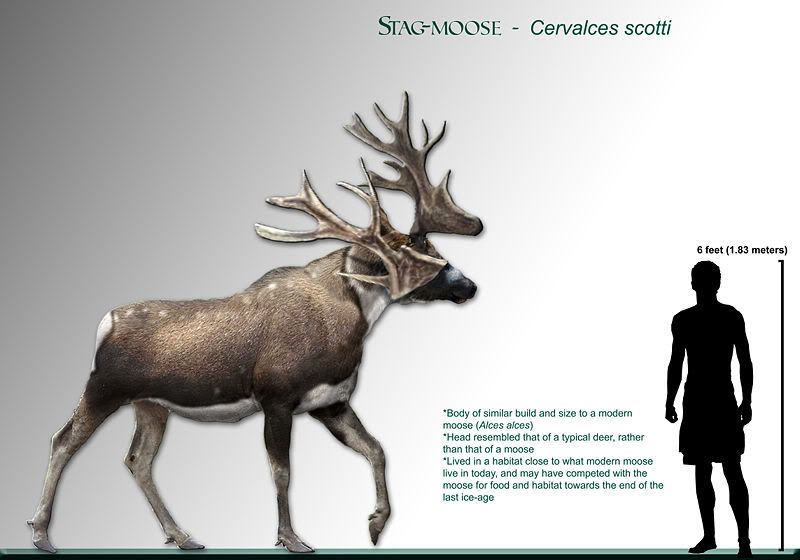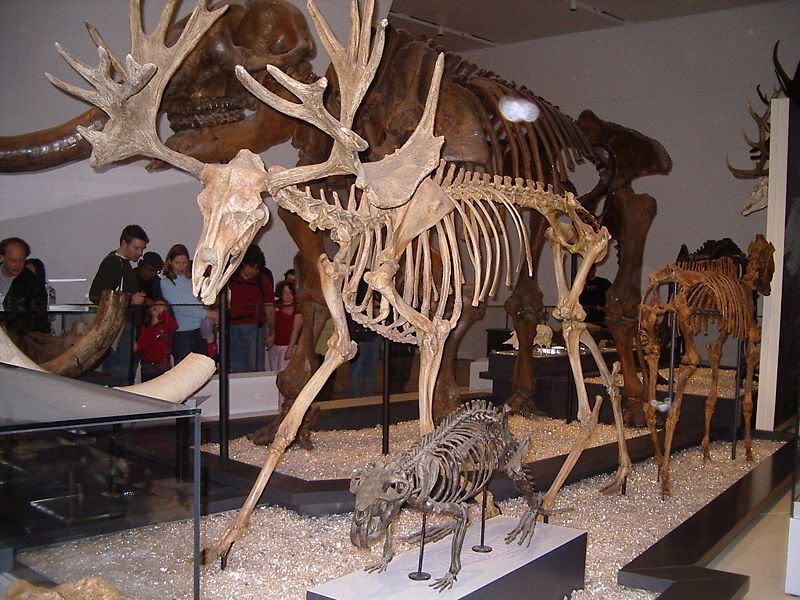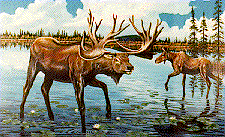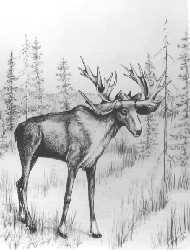|
|
Post by dantheman9758 on Mar 29, 2007 15:55:47 GMT
 The Cervalces scotti or "Stag-moose" as it is commonly called, was a type of moose that lived exclusively in North America during the late Pleistocene. It gets its name from the fact that it had a body that looked like a moose, but a head that looked like it belonged to a deer or elk. Both the stag-moose, and the modern moose shared a common ancestor (although I'm not sure how far back) and are classic examples of how sexual selection, and natural selection can produce two physiologically different species, even though they both preferred the same habitat and lived in similar conditions. Both of these animals lived in forested marshy environments and both of these animals have somewhat similar adaptations to show for it (stilt-like legs for wading in ponds and marshes). The evolutionary path of the moose was paved more by "natural selection" than by sexual selection. The skull and facial adaptations on a moose are clearly more specialized at swamp browsing, and probably gave it a mild competitive edge over the stag-moose (perhaps ensuring its survival of the Pleistocene extinction?) . The stag-moose on the other hand possessed a much more conservative "deer-like" head - much like its ancestors had. What the stag-moose lacked in specialized adaptations it certainly made up for with its impressive display of antlers. The antlers it wore were both large, and bizarre looking compared to a modern deer. A strong indication that sexual selection was much more active in this species of moose, than in the Alces alces species of modern moose. Because I believe that sexual selection was a relatively strong factor in the evolution of the stag-moose, I have chosen to give it a fur pattern that is equally "different" from most modern deer. If i was to render a "stag-moose" professionally for a museum however, I would conservatively just make it all brown in color, with no "outside the box" coloring. Anyways I thought people might be interested in the stag-moose and I always hear sources claiming it was "larger than a modern moose" - However I have only been able to find Hard evidence (museum skeletal measurments) that indicate this animal had a 6' shoulder height (somewhat smaller than a modern moose) ---- If anybody can find some hard evidence as to the size or weight of this animal it would be greatly appreciated, as I could use it for some future projects that I'm working on www.angellis.net/Web/PDfiles/ungartio.pdf(source of shoulder height) en.wikipedia.org/wiki/Stag-mooseen.wikipedia.org/wiki/Moose |
|
|
|
Post by another specialist on May 30, 2008 18:17:57 GMT
The "stag-moose" The stag-moose (Cervalces scotti) is an extinct deer slightly larger than the modern moose. Its name, stag-moose, refers to the fact that it looks much like a cross between an elk and a moose. If you had been able to see the stag-moose alive, you may well have thought it was a moose on stilts with the face of an elk. The stag-moose had complex PALMATE antlers. So-called as they are shaped like the palm of a hand, i.e. they have large flat areas and thinner projections. The stag-moose was found in deposits in mid-western America that indicate that it probably preferred swamps, bogs, and other wetlands in environments like the tundra and spruce parklands. This habitat is similar to that preferred by the modern moose. In fact, the stag-moose probably led a very similar lifestyle. Unfortunately the stag-moose became extinct sometime between 11,000 and 10,000 years ago.The colour image (below) is a reproduction of a painting at the Illinois State Museum. www.smouse.force9.co.uk/history.htm |
|
|
|
Post by another specialist on May 30, 2008 18:24:42 GMT
|
|
|
|
Post by another specialist on May 30, 2008 18:27:51 GMT
  Stag-moose (Cervalces scotti) fossil at the ROM The Stag-moose or Stag moose (Cervalces scotti) was a large moose-like deer of North America of the Pleistocene era.[1] It was slightly larger than the moose, with an elk-like head, long legs, and complex palmate antlers. The species went extinct approximately 11,500 years ago, toward the end of the most recent ice age, as part of a mass extinction of large North American mammals.[2][3] The first evidence of the stag-moose found in modern times was discovered at Big Bone Lick, Kentucky by William Clark, ca. 1805. A more complete skeleton was found in 1885 by William Barryman Scott in New Jersey.[1] The stag-moose frequented wetlands in a range from southern Canada to Arkansas and from Iowa to New Jersey. As the glaciers retreated, moose (which had crossed the Bering land bridge from Asia)[4] may have populated its habitat and caused its extinction by competition.[1] Although there is no paleontological evidence that it was associated with humans,[5] other theories for its extinction have been proposed. Notably, there is speculation that hunting by newly-arrived humans caused the extinction of the stag-moose and other large mammals.[6] Additionally, some have proposed a sudden extinction by disease, brought by small mammals in association with humans.[3] en.wikipedia.org/wiki/Stag-moose |
|
|
|
Post by another specialist on May 30, 2008 18:32:12 GMT
|
|
|
|
Post by another specialist on May 30, 2008 18:33:01 GMT
 Stag Moose (Cervalces scotti) Cervalces was unusual. It had a deer-like face but a moose's body and strange broad antlers that stood out straight from either side of its head. Each antler branched into irregular tines and spikes that extended in all directions - some of them backward. As fossils, the antlers, which are distinctive, are commonly preserved whereas relatively complete skeletons are rare. Long-legged and large, it could feed in relatively deep water of wetlands on the tundra or in the spruce forests. In Illinois, it apparently lived mostly in the northern half of the state. It was common in the surrounding states but was never abundant. It ranged over much of North America. Cervalces origin is obscure. Nevertheless, it is known to have been in North America more than 25,000 years ago. It survived until some 10,000 years ago. Cervalces probably was displaced by the modern moose, which invaded from Eurasia, crossing on the Bering Strait land bridge. www.isgs.uiuc.edu/education/ice-age-res/stag.shtml |
|
|
|
Post by another specialist on Aug 11, 2008 17:16:23 GMT
 A Study of Fossil Vertebrate Types in the Academy of Natural Sciences of Philadelphia: Taxonomic, Systematic, and Historical Perspectives By Earle E. Spamer, Earle E. Spamer Edward Daeschler L. Gay Vostreys-Shapiro, Edward Daeschler, L. Gay Vostreys-Shapiro |
|
|
|
Post by surroundx on Nov 11, 2015 10:18:54 GMT
Glotzhober, Robert C. and McDonald, H. Gregory. (2015). Partial Skeleton of an Elk-moose, Cervalces scotti, from Chippewa Lake, Medina County, Ohio. PaleoAmerica 1(4): 332-342. [ Abstract] |
|
|
|
Post by Melanie on Nov 11, 2015 13:52:53 GMT
Glotzhober, Robert C. and McDonald, H. Gregory. (2015). Partial Skeleton of an Elk-moose, Cervalces scotti, from Chippewa Lake, Medina County, Ohio. PaleoAmerica 1(4): 332-342. [ Abstract] Rather certaily a Pleistocene/Holocene border extinction |
|
|
|
Post by surroundx on Jan 26, 2016 4:20:23 GMT
|
|
|
|
Post by Melanie on Oct 26, 2018 23:56:48 GMT
Seems that it is indeed survived into the Holocene. From Martin & Klein (Quarternary Extinctions: A Prehistoric Revolution:
Stag-moose. 1 sp. RLB-E Holoc. Alberta, Saskatchewan, and EC U.S. C. scotti (Lydekker) has been identified at more than twenty Wisconsinan faunas, and two complete skeletons have been found in New Jersey bogs. It was about the size of a moose with long limbs and complexly palmated antlers. It probably inhabited muskegs. No associations with man are known, and the cause of its extinction was probably competition with Alces alces and a restricted geographic range. (Kurten and Anderson 1980)
|
|











